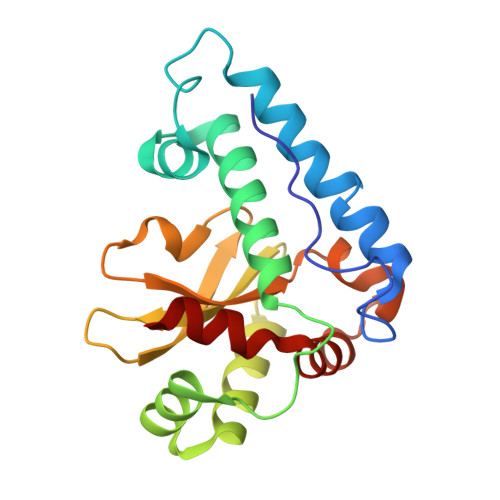Structural and denaturation studies of two mutants of a cold adapted superoxide dismutase point to the importance of electrostatic interactions in protein stability.
Merlino, A., Russo Krauss, I., Castellano, I., Ruocco, M.R., Capasso, A., De Vendittis, E., Rossi, B., Sica, F.(2014) Biochim Biophys Acta 1844: 632-640
- PubMed: 24440460
- DOI: https://doi.org/10.1016/j.bbapap.2014.01.007
- Primary Citation of Related Structures:
4L2A, 4L2B, 4L2C, 4L2D - PubMed Abstract:
A peculiar feature of the psychrophilic iron superoxide dismutase from Pseudoalteromonas haloplanktis (PhSOD) is the presence in its amino acid sequence of a reactive cysteine (Cys57). To define the role of this residue, a structural characterization of the effect of two PhSOD mutations, C57S and C57R, was performed. Thermal and denaturant-induced unfolding of wild type and mutant PhSOD followed by circular dichroism and fluorescence studies revealed that C→R substitution alters the thermal stability and the resistance against denaturants of the enzyme, whereas C57S only alters the stability of the protein against urea. The crystallographic data on the C57R mutation suggest an involvement of the Arg side chain in the formation of salt bridges on protein surface. These findings support the hypothesis that the thermal resistance of PhSOD relies on optimization of charge-charge interactions on its surface. Our study contributes to a deeper understanding of the denaturation mechanism of superoxide dismutases, suggesting the presence of a structural dimeric intermediate between the native state and the unfolded state. This hypothesis is supported by the crystalline and solution data on the reduced form of the enzyme.
- Dipartimento di Scienze Chimiche, Università di Napoli "Federico II", Complesso Universitario di Monte Sant'Angelo, I-80126 Napoli, Italy; Istituto di Biostrutture e Bioimmagini, CNR, Via Mezzocannone 16, I-80134 Napoli, Italy.
Organizational Affiliation:



















